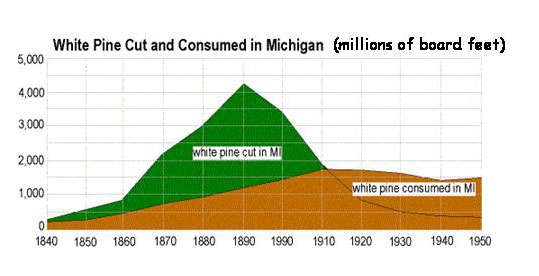| Let's use the logging as an example to answer the basic economic geography
questions about "what" products and services are produced and "how"
they are produced (that is, with what combination of resources), as well as
"where" they are produced and "why there". Beginning with the first
settlements in Michigan by white man, waterpowered mills
sawed oak and maple for local use, but after 1840 the state became an exporter of
pine. Loggers cut white pine and red pine in northern forests and hammered the
owner's logmark into the ends of each timber.
Registered in county courthouses, the first logmarks were usually one or two simple
initials, but latecomers introduced variations to avoid duplication. In winter
teamsters moved the logs by sleigh down icy roads to rollways on a riverbank a few miles
away. During the spring flood rivermen rolled the logs into the water and drove them
downsteam to logbooms at rivermouth towns such as Saginaw, Muskegon, Alpena, and
Menominee. There the pine was sorted by logmark, sawed into lumber for each owner,
and shipped by lakes or by rail to Chicago and the almost treeless Midwestern prairies
beyond. Pine logging became a year-round occupation after "big wheels"
permitted horses to drag logs across snowless ground and narrow-gauge railroads replaced
rivers when they were low in summer or iced over in winter. After 1910 Michigan
became a net importer of lumber, but its pine and hardwood had helped to create a
furniture industry in Grand Rapids, an auto industry in southeast Michigan, and a network
of railroads, milltowns, and supply points across the north country. |
